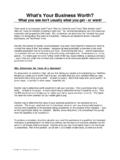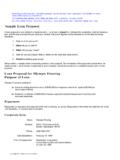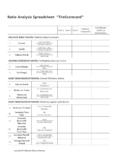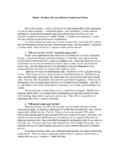Transcription of ADD Financial Gap Calculation Worksheet - brs …
1 + Financial Gap Calculation Worksheet Assets % of Sales* Liabilities % of Sales* Cash Notes Payable Financial Gap =+ Accounts Receivable Accounts Payable + InventoryAccruals = Total Current Assets Total Current Liabilities = Equipment Long-Term Liabilities + Land/Building (fixed) Total Liabilities == Total Fixed Assets Net Worth = Total Assets=Total Liabilities & Net Worth Financial Gap Illustrated The Financial Gap forecasting section provides a tool to understand how a business growth (as measured by its Sales on the Income Statement), can affect its need for additional assets (which are measured and paid for on the Balance Sheet). The process involves first identifying which assets and/or liabilities vary with sales. Variable Assets usually include cash, A/R, inventory, and equipment. Variable Liabilities are usually accruals and A/P.
2 These can vary with different companies. Once we ve identified the company s variable assets and liabilities, we then develop a percentage of sales relationship between the dollar amounts from the balance sheet of each variable asset and liability to the sales that were produced during the year. These percentage of sales relationships will be used to forecast what the balance sheet may look like in the future, based on different levels of anticipated sales. Forecasting the balance sheet requires four basic steps: the New Net Worth the dollars for the variable assets and variable the rest of the balance sheet numbers the potential Financial GapADD GOING DOWN 1. New Net WorthBegin by determining the existing net worth number from the historic balance sheet . In the future, the only thing that will add to the existing net worth will be the company s profit.
3 Multiply the projected sales times the projected net profit percentage to obtain the projected profit dollars. Add the projected profit dollars to the existing net worth to obtain the new net worth. 2. Forecasting dollars of variable assets and variable liabilitiesMultiply the percentage of sales number for each variable asset or liability times the projected total sales to obtain the forecasted balance sheet number. 3. The illustration below shows the process of completing the balance sheet. Start at the top of theAsset side of the balance sheet, and add numbers to one another until you arrive at the Total Assets number on the bottom. Since the balance sheet has to balance, the number in Total Assets is then repeated at the bottom right of the balance sheet in Total Liabilities and Net Worth. From there, work up the left side of the balance sheet, subtracting numbers from one another, until you arrive at Financial Gap (Notes Payable) at the top.
4 4. Calculating the potential Financial GapBy now, you have determined what the company s projected Total Current Liabilities number will be, which is always the sum of all the numbers above it. To determine the Financial Gap figure, subtract the accruals and accounts payable numbers from Total Current Liabilities copyright 2018 Business Resource Services








